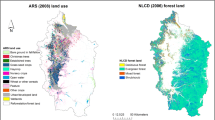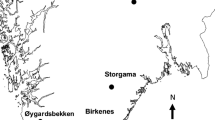Abstract
We present the first estimates of net anthropogenic nitrogen input (NANI) in European boreal catchments. In Swedish catchments, nitrogen (N) deposition is a major N input (31–94%). Hence, we used two different N deposition inputs to calculate NANI for 36 major Swedish catchments. The relationship between riverine N export and NANI was strongest when using only oxidized deposition (NOy) as atmospheric input (r2 = 0.70) rather than total deposition (i.e., both oxidized and reduced nitrogen, NOy + NHx deposition, r2 = 0.62). The y-intercept (NANI = 0) for the NANI calculated with NOy is significantly different from zero (p = 0.0042*) and indicates a background flux from the catchment of some 100 kg N km−2 year−1 in addition to anthropogenic inputs. This agrees with similar results from North American boreal catchments. The slope of the linear regressions was 0.25 for both N deposition inputs (NOy and NOy + NHx), suggesting that on average, 25% of the anthropogenic N inputs is exported by rivers to the Baltic Sea. Agricultural catchments in central and southern Sweden have increased their riverine N export up to tenfold compared to the inferred background flux. Although the relatively unperturbed northernmost catchments receive significant N loads from atmospheric deposition, these catchments do not show significantly elevated riverine N export. The fact that nitrogen export in Swedish catchments appears to be higher in proportion to NANI at higher loads suggests that N retention may be saturating as loading rates increase. In northern and western Sweden the export of nitrogen is largely controlled by the hydraulic load, i.e., the riverine discharge normalized by water surface area, which has units of distance time−1. Besides hydraulic load the percent total forest cover also affects the nitrogen export primarily in the northern and western catchments.





Similar content being viewed by others
Abbreviations
- BB:
-
Bothnian Bay
- BP:
-
Baltic proper
- BS:
-
Bothnian Sea
- EMEP:
-
Co-operative programme for monitoring and evaluation of the long-range transmission of air pollutants in Europe; http://www.emep.int
- EU:
-
European Union
- FAO:
-
Food and agriculture organization of the United Nations; http://www.fao.org
- HL:
-
Hydraulic load i.e., the average annual riverine flow per unit surface area of waters in the catchment
- KT:
-
Kattegat
- N:
-
Nitrogen
- NANI:
-
Net anthropogenic nitrogen input
- NOy :
-
Oxidized nitrogen deposition i.e., NO, NO2, HNO3, NO3 − and Peroxyacetyl nitrate (PAN)
- NHx :
-
Reduced nitrogen deposition i.e., NH3, NH4 +
- TN:
-
Total nitrogen
- WFD:
-
Water framework directive
References
Ahtiainen M, Huttunen P (1999) Long-term effects of forestry managements on water quality and loading in brooks. Boreal Environ Res 4:101–114
Alexander RB, Johnes PJ, Boyer EW, Smith RA (2002) A comparison of models for estimating the riverine export of nitrogen from large watersheds. Biogeochemistry 57(1):295–339
Behrendt H, Opitz D (1999) Retention of nutrients in river systems: dependence on specific runoff and hydraulic load. Hydrobiologia 410:111–122
Bleken MA, Bakken LR (1997) The nitrogen cost of food production: Norwegian society. Ambio 26(3):134–142
Boyer EW, Goodale CL, Jaworsk NA, Howarth RW (2002) Anthropogenic nitrogen sources and relationships to riverine nitrogen export in the northeastern USA. Biogeochemistry 57(1):137–169
Dentener FJ, Crutzen PJ (1994) A three-dimensional model of the global ammonia cycle. J Atmos Chem 19(4):331–369
Dise NB, Wright RF (1995) Nitrogen leaching from European forests in relation to nitrogen deposition. For Ecol Manage 71(1–2):153–161
Fagerli H, Simpson D, Tsyro S (2004) Transboundary acidification, eutrophication and ground level ozone in Europe. EMEP status report 1/2004, The Norwegian Meteorological Institute, Oslo, Norway, pp 1–18
FAO (2000) Food balance sheets. FAOSTAT. Food and Agriculture of the United Nations, Rome
Frankow-Lindberg BE (2003) Kvantifiering av kvävefixering via baljväxter i fält - förslag till ny modell i rådgivningsprogrammet STANK, Rapport 5. Institutionen för ekologi och växtproduktionslära, SLU, Uppsala, p 28
Galloway JN, Dentener FJ, Capone DG, Boyer EW, Howarth RW, Seitzinger SP, Asner GP, Cleveland CC, Green PA, Holland EA, Karl DM, Michaels AF, Porter JH, Townsend AR, Vorosmarty CJ (2004) Nitrogen cycles: past, present, and future. Biogeochemistry 70(2):153–226
Hägg HE, Humborg C, Mörth CM, Rodriguez Medina M, Wulff F (2010) Scenario analysis on protein consumption and climate change effects on riverine N export to the Baltic Sea. Environ Sci Technol 44(7):2379–2385
Han HJ, Allan JD (2008) Estimation of nitrogen inputs to catchments: comparison of methods and consequences for riverine export prediction. Biogeochemistry 91(2–3):177–199
Han HJ, Allan JD, Scavia D (2009) Influence of climate and human activities on the relationship between watershed nitrogen input and river export. Environ Sci Technol 43(6):1916–1922
Howarth RW, Billen G, Swaney D, Townsend A, Jaworski N, Lajtha K, Downing JA, Elmgren R, Caraco N, Jordan T, Berendse F, Freney J, Kudeyarov V, Murdoch P, Zhu ZL (1996) Regional nitrogen budgets and riverine N&P fluxes for the drainages to the North Atlantic Ocean: natural and human influences. Biogeochemistry 35(1):75–139
Howarth RW, Boyer EW, Pabich WJ, Galloway JN (2002) Nitrogen use in the United States from 1961–2000 and potential future trends. Ambio 31(2):88–96
Howarth RW, Swaney DP, Boyer EW, Marino R, Jaworski N, Goodale C (2006) The influence of climate on average nitrogen export from large watersheds in the Northeastern United States. Biogeochemistry 79(1–2):163–186
Humborg C, Smedberg E, Rodriguez Medina M, Mörth CM (2008) Changes in dissolved silicate loads to the Baltic Sea—the effects of lakes and reservoirs. J Mar Syst 73(3–4):223–235
Jones B (1931) Factors for converting percentages of nitrogen in foods and feeds into percentages of proteins. In: US Department of Agriculture (slightly revised August 1941)
Jordan TE, Weller DE (1996) Human contributions to terrestrial nitrogen flux. Bioscience 46(9):655–664
Jordbruksverket (2002) Stallgödsel och växtnäring i kretslopp (STANK) Jordbrukets växtnäringsprogram (Plant nutrient balance calculation program). SJV (Swedish Board of Agriculture), Jönköping
Kellogg RL, Lander CH, Moffitt DC, Gollehon N (2000) Manure nutrients relative to the capacity of cropland and pastureland to assimilate nutrients: spatial and temporal trends for the United States. U.S. Department of Agriculture, National Resources Conservation Service, Kansas
Larsson U, Elmgren R, Wulff F (1985) Eutrophication and the Baltic Sea: causes and consequences. Ambio 14:9–14
Lewis WM (2002) Yield of nitrogen from minimally disturbed watersheds of the United States. Biogeochemistry 57(1):375–385
Lewis WM, Melack JM, McDowell WH, McClain M, Richey JE (1999) Nitrogen yields from undisturbed watersheds in the Americas. Biogeochemistry 46(1–3):149–162
Mulligan D, Bouraoui F, Grizzetti B, Aloe A, Dusart J (2006) An atlas of pan-European data for investigating the fate of agrochemicals in terrestrial ecosystems office for official publications of the European Communities Luxembourg, European Communities
Neff JC, Holland EA, Dentener FJ, McDowell WH, Russell KM (2002) The origin, composition and rates of organic nitrogen deposition: a missing piece of the nitrogen cycle? Biogeochemistry 57(1):99–136
Rodriguez Medina M, Savchuk OP, Wulff F (2006) Reconstruction of riverine nutrient loads to the Baltic Sea 1970–2000. Research and Management of Eutrophication in Coastal Ecosystems, Nyborg, Denmark
SCB (2001a) Animal products 2000, yearly & monthly statistics, Statistiska meddelanden JO 48 SM 0203. Statistiska centralbyrån & Jordbruksverket
SCB (2001b) Hectarskördar och totalskördar 2000, Definitiva resultat (Crop yield per hectare and total production in 2000, Final results), Statistiska meddelanden JO 16 SM 0101. Statistiska centralbyrån & Jordbruksverket
SCB (2003) Statistical data for drainage areas 2000. Sveriges officiella statistik, MI11 SM0301, p 105
Simpson D, Fagerli H, Jonson JE, Tsyro S, Wind P, Tuovinen J-P (2003) Transboundary acidification and eutrophication and ground level ozone in Europe: unified EMEP model description, EMEP status report 1/2003 part I. The Norwegian Meteorological Institute, Oslo, Norway
Smith SV, Swaney DP, Talaue-McManus L, Bartley JD, Sandhei PT, McLaughlin CJ, Dupra VC, Crossland CJ, Buddemeier RW, Maxwell BA, Wulff F (2003) Humans, hydrology, and the distribution of inorganic nutrient loading to the ocean. Bioscience 53(3):235–245
Smith SV, Swaney DP, Buddemeier RW, Scarsbrook MR, Weatherhead MA, Humborg C, Eriksson H, Hannerz F (2005) River nutrient loads and catchment size. Biogeochemistry 75(1):83–107
Stålnacke P, Grimvall A, Sundblad K, Tonderski A (1999) Estimation of riverine loads of nitrogen and phosphorus to the Baltic Sea, 1970–1993. Environ Monit Assess 58(2):173–200
Tamm C (1991) Nitrogen in terrestrial ecosystems: questions of productivity, vegetational changes, and ecosystem stability. Springer Verlag, Berlin, New York
Vance ED, Chapin FS (2001) Substrate limitations to microbial activity in taiga forest floors. Soil Biol Biochem 33(2):173–188
Vitousek PM, Aber JD, Howarth RW, Likens GE, Matson PA, Schindler DW, Schlesinger WH, Tilman DG (1997) Human alteration of the global nitrogen cycle: sources and consequences. Ecol Appl 7(3):737–750
Wiklander G, Nordlander G, Andersson R (1991) Leaching of nitrogen from a forest catchment at Soderasen in Southern Sweden. Water Air Soil Pollut 55(3–4):263–282
Acknowledgments
We thank the EU BONUS plus project RECOCA (http://www.bonusportal.org) for financing this study. Further we extent our gratitude Elisabeth W. Boyer and Penny Johnes for help with the data calculation spreadsheets and for sharing their knowledge in budget calculations. The authors also express their gratitude to Department of Aquatic Sciences and Assessment, SLU, Sweden for kindly providing river load data.
Author information
Authors and Affiliations
Corresponding author
Rights and permissions
About this article
Cite this article
Eriksson Hägg, H., Humborg, C., Swaney, D.P. et al. Riverine nitrogen export in Swedish catchments dominated by atmospheric inputs. Biogeochemistry 111, 203–217 (2012). https://doi.org/10.1007/s10533-011-9634-7
Received:
Accepted:
Published:
Issue Date:
DOI: https://doi.org/10.1007/s10533-011-9634-7




